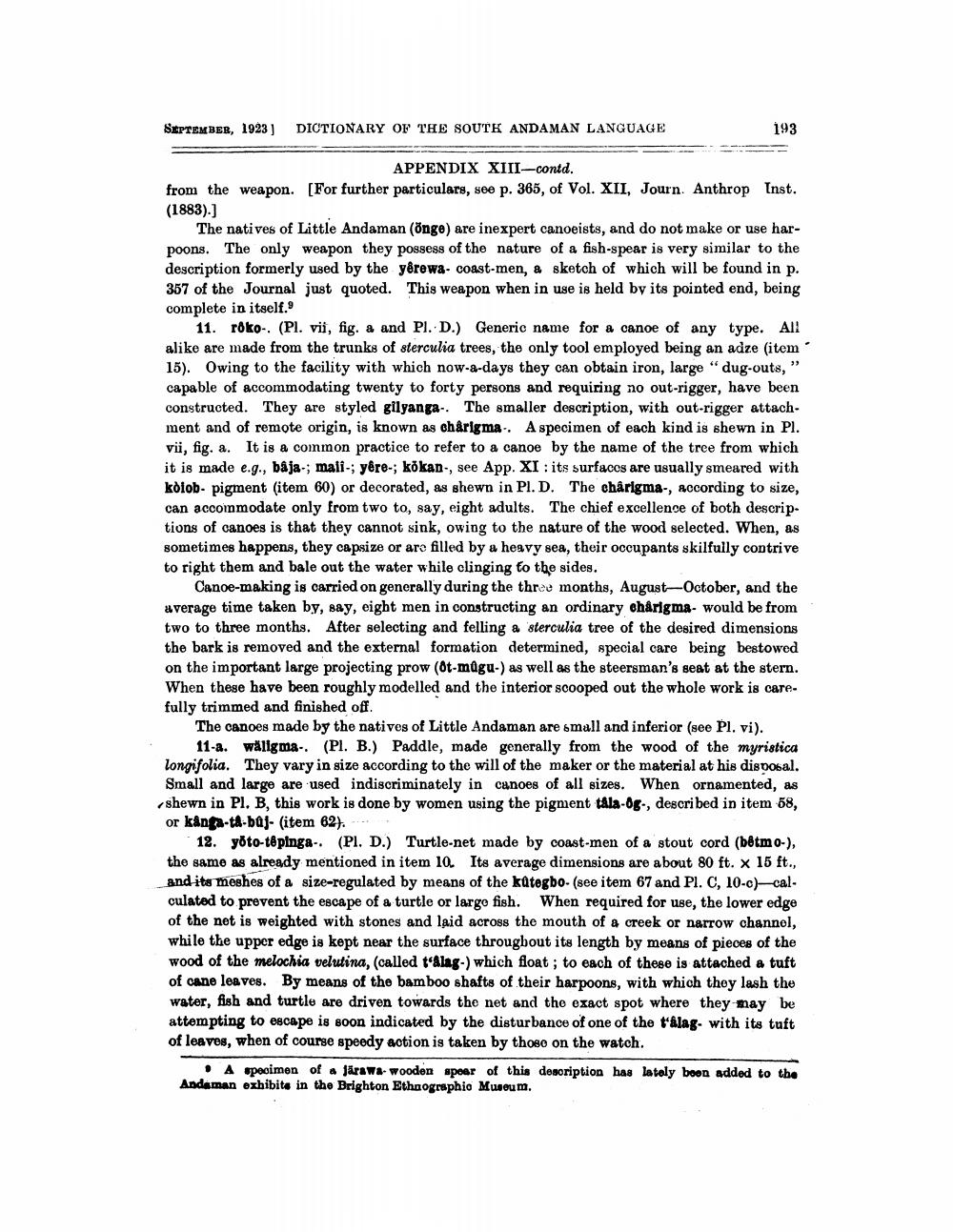________________
SEPTEMBER, 1923) DICTIONARY OF THE SOUTK ANDAMAN LANGUAGE
193
APPENDIX XIII-contd. from the weapon. (For further particulars, see p. 365, of Vol. XII, Journ. Anthrop Inst. (1883).)
The natives of Little Andaman (önge) are inexpert canoeists, and do not make or use harpoons. The only weapon they possess of the nature of a fish-spear is very similar to the description formerly used by the yêrewa- coast-men, & sketch of which will be found in p. 357 of the Journal just quoted. This weapon when in use is held by its pointed end, being complete in itself.
11. roko. (Pl. vii, fig. a and Pl. D.) Generic name for a canoe of any type. All alike are made from the trunks of sterculia trees, the only tool employed being an adze (item 15). Owing to the facility with which now-a-days they can obtain iron, large "dug-outs,” capable of accommodating twenty to forty persons and requiring no out-rigger, have been constructed. They are styled gilyanga-. The smaller description, with out-rigger attachment and of remote origin, is known as chårigma. A specimen of each kind is shewn in Pl. vii, fig. a. It is a common practice to refer to a canoe by the name of the tree from which it is made e.g., baja-, mali-; yêre-; kokan-, see App. XI : its surfaces are usually smeared with kõiob- pigment (item 60) or decorated, as shewn in PI.D. The chårigma-, according to size, can accommodate only from two to, say, eight adults. The chief excellence of both descriptions of canoes is that they cannot sink, owing to the nature of the wood selected. When, as sometimes happens, they capsize or are filled by a heavy sea, their occupants skilfully contrive to right them and bale out the water while clinging to the sides.
Canoe-making is carried on generally during the three months, August-October, and the average time taken by, say, eight men in constructing an ordinary chårigma- would be from two to three months. After selecting and felling a sterculia tree of the desired dimensions the bark is removed and the external formation determined, special care being bestowed on the important large projecting prow (0t-mûgu.) as well as the steersman's seat at the stern. When these have been roughly modelled and the interior scooped out the whole work is carefully trimmed and finished off.
The canoes made by the natives of Little Andaman are small and inferior (see Pl. vi).
11-a. waligma-. (Pl. B.) Paddle, made generally from the wood of the myristica longifolia. They vary in size according to the will of the maker or the material at his disposal, Small and large are used indiscriminately in canoes of all sizes. When ornamented, as shewn in Pl. B, this work is done by women using the pigment tala-08-, described in item 58, or kanga-ta-baj- (item 62).
12. yöto-tépinga-. (PI. D.) Turtle-net made by coast-men of a stout cord (bêtmo-), the same as already mentioned in item 10. Its average dimensions are about 80 ft. x 15 ft., and its meshes of a size-regulated by means of the kategbo- (see item 67 and Pl. C, 10-c)calculated to prevent the escape of a turtle or large fish. When required for use, the lower edge of the net is weighted with stones and laid across the mouth of a creek or narrow channel, while the upper edge is kept near the surface througbout its length by means of pieces of the wood of the melochia velutina, (called talag-) which float; to each of these is attached a tuft of cane leaves. By means of the bamboo shafts of their harpoons, with which they lash the water, fish and turtle are driven towards the net and the exact spot where they may be attempting to escape is soon indicated by the disturbance of one of the t'klag- with its tuft of leaves, when of course speedy action is taken by those on the watch.
A specimen of a järswa- wooden spoor of this desoription has lately boon added to the Andaman exhibita in the Brighton Ethnographio Museum.




